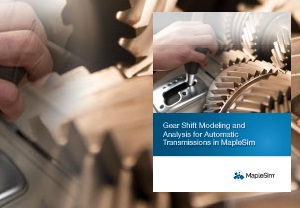
 |
Charlotte Stonestreet
Managing Editor |
Gear Shift Modelling and Analysis for Automatic Transmissions: new technical whitepaper
28 September 2015
How can vehicle manufacturers smooth out the effects of a gear shift on passengers, determine the ideal combination of normal forces applied to clutches, and quickly and safely experiment with multiple permutations to determine the optimum? Maplesoft explains.

Gear shifting in vehicles with automatic transmissions is an important topic in the automotive powertrain industry, as evidenced by the sheer number of studies published over the past few decades.
When a vehicle’s transmission is operating, one gear is fully engaged, and the engine speed increases, while its output torque decreases. During gear shift, the off-going clutch is released while the oncoming clutch engages - producing disturbances in the engine’s output torque which passengers experience as ride discomfort. Since these disturbances are undesirable, gear shifting should be performed in such a way as to minimize vibration in the drivetrain.
In this paper, a simple dynamic physical model of an automatic transmission was created to evaluate all required forces and motion characteristics of the system during the shift process. Gear shift quality was assessed by setting different timing sequences for the engage/disengage process of the frictional components (pressure on the clutches), during the upshift process. The output torque of the transmission was analyzed under two conditions, with the timing to apply/remove pressure from the clutches being different in both cases.
Download the full whitepaper to learn more here.
- No related articles listed


















